The Chancay Megaport: Opportunities, Challenges and China’s Influence in Peru
The new Chancay mega-port, inaugurated during the APEC summit in Peru, symbolizes the country’s transformation into a strategic hub for trade between Asia and Latin America, but also poses geopolitical and social challenges. With the financial backing and majority control of COSCO, a Chinese state-owned company, the port promises to reduce transport times and costs, attract investment and generate local employment. However, this partnership has sparked debate about Chinese influence in strategic Peruvian sectors, the impact on local communities and the possible dependence on an external actor with its own objectives. In a context of immediate economic benefits and long-term risks, Peru will have to face the implications of a project that could change not only its economy, but also its role in Pacific trade dynamics.
This week, during the APEC summit in Lima, the newly renamed Port of Chancay will be officially inaugurated. The summit will host a lineup of high-profile figures, including top executives from international corporations, banking conglomerates, tech leaders, and political representatives, notably Chinese President Xi Jinping. The national anticipation surrounding the event led the Peruvian government to declare non-working days for APEC, even extending this policy to the province where the new port is located.
It’s no surprise that the fanfare is immense. The Port of Chancay, located about 80 kilometers north of Lima, has become one of the most ambitious infrastructure projects in Peru’s recent history. Although the project was originally conceived in 2007, it garnered significant attention in 2019 when China’s state-owned COSCO Shipping Ports acquired a 60% stake in Terminales Portuarios Chancay for $225 million, forming a partnership with Peruvian mining company Volcan, which holds the remaining 40%. Chancay will become the first port in the Western Hemisphere entirely under the control of the Chinese shipping giant, unlike COSCO’s limited involvement at the Port of Seattle in the United States, where its role is restricted to operating a single terminal..

Photo: Presidencia Perú Flickr. Inspection of the progress of the Chancay Port Terminal and presentation of the first electric cranes. 14/06/2024
Although the project was originally conceived in 2007, it garnered significant attention in 2019 when China’s state-owned COSCO Shipping Ports acquired a 60% stake in Terminales Portuarios Chancay for $225 million, forming a partnership with Peruvian mining company Volcan, which holds the remaining 40%.
The financing for the port comes largely from Chinese capital, underscoring China’s growing presence in the Peruvian economy. Peru ended up finding in China a partner willing to invest and bet on the Andean coast, something that experts say “does not interest” other major powers such as the United States, Brazil, or members of the European Union.
“The Chinese model consists of building a global distribution point in a new subcontinent that does not have that,” explains Omar Narrea, a researcher at the Center for China and Asia-Pacific Studies at the Universidad del Pacífico in Peru, who points to China’s investment record in Africa as an example of Beijing’s model.
“We have ports with similar depths and geographic capabilities, but not with that technology. That technology comes from the interest of the investor, and of the company, to have an efficient point through which to change global distribution networks. So it is not only production and consumption, but also distribution,” Narrea says.
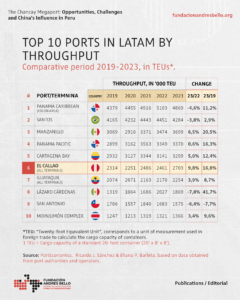
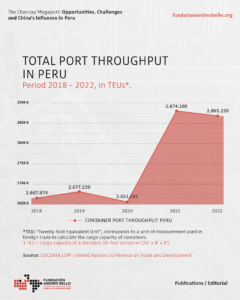
This partnership has generated both expectations and concerns, as the large Chinese investment has given rise to debates about economic sovereignty and the balance of power in the region. The investment covers not only the construction of cargo terminals, but also the modernization of road and rail infrastructure that will connect the port to Lima and other major cities.
COSCO has committed to carry out the work in several phases, with the first phase focusing on the construction of docks, storage areas and automated crane systems. As the port moves towards completion, it is expected to become a central node in the trade network between Asia and South America, attracting investment and generating local employment.
The Chancay port is not only an economic project; it also represents a piece on the global geopolitical chessboard where China has consolidated its influence by funding strategic infrastructure.
Through its global Belt and Road Initiative, China has developed a network of projects in various countries with the goal of developing infrastructure while at the same time increasing its economic and political influence. This soft power allows China to deepen its relations with participating nations by offering investments in key sectors such as transportation, energy and telecommunications, often in exchange for privileged access to markets and resources.
China’s presence in Latin America has grown exponentially in recent decades. In countries such as Ecuador, for example, China financed and built the Coca Codo Sinclair Dam, the country’s largest hydroelectric power plant. While this project was initially seen as a development opportunity, opacity, technical problems and cost overruns caused tensions between the Ecuadorian government and its Chinese partners, demonstrating the risks of over-reliance on external financing.
In Argentina, the construction of a Chinese space monitoring base in the province of Neuquén generated controversy due to suspicions about its use for military or intelligence purposes, raising alarms about the loss of control over strategic infrastructure.
The Chancay port project could follow a similar dynamic. As COSCO is a Chinese state-owned company, decisions on the operation of the port could well be linked to the interests of the Chinese government. This asymmetrical relationship raises concerns about Peru’s sovereignty and the risk of the country being dependent on a foreign actor for the operation of vital infrastructure.
While Chinese investment brings tangible benefits, some analysts fear that China could use its influence over the port to pressure Peru on foreign policy or trade issues, consolidating its role as the region’s main partner at the expense of other global players.
“COSCO continues to apply this logic of transforming global shipping networks, as it is one of the leading companies in doing so. They realize that [Chancay] is an important point in trade for this area, it is going to increase consumption, and they see it from a commercial point of view,” Narrea adds.
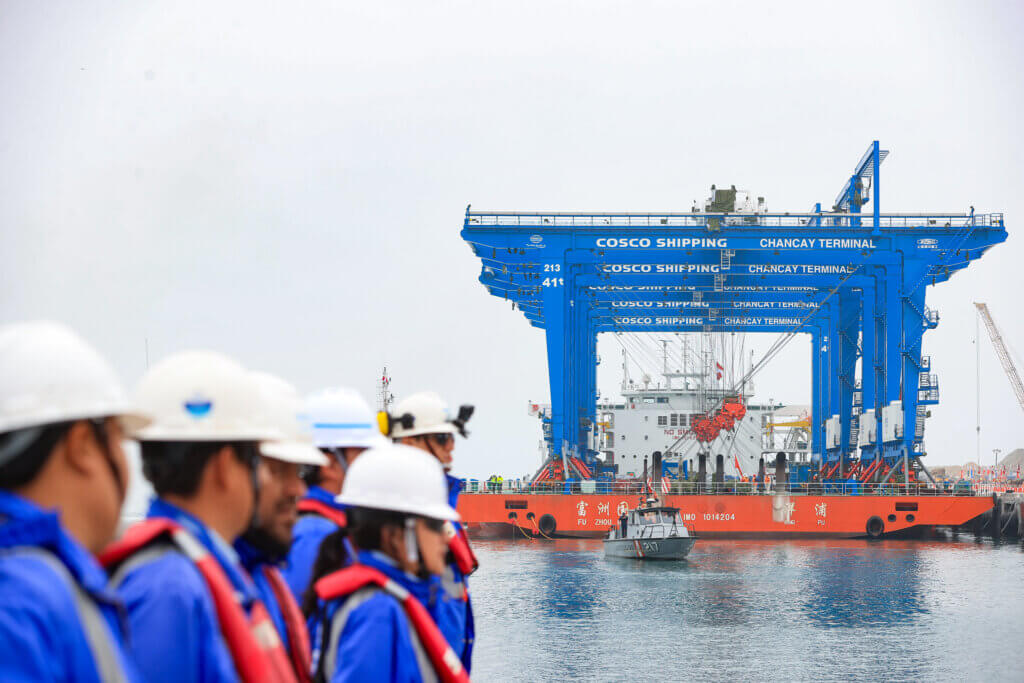
Photo: Presidencia Perú Flickr. Inspection of the progress of the Chancay Port Terminal and presentation of the first electric cranes. 14/06/2024
In this sense, Chancay is not just a port, but one more piece in China’s global strategy to position itself as a commercial and political leader in regions that have traditionally been under the influence of other powers, such as the United States and Europe. The question remains whether Peru will be able to balance the economic benefits of the port with the geopolitical challenges arising from its partnership with China.
When discussing the management and control of the port, there is rising concern on whether it could be used for other purposes that are not commercial. The general assumption is that decisions are made unilaterally. This would ignore Peru’s business and investment regulations as well as the Peruvian laws regarding commercial port usage, which indicates that any entry that is not for commercial purposes requires the approval of Congress and the Executive Power.
“Right now, the port’s main goal is to open a logistics market for Peru and further China’s economic access to the region. How countries navigate and make sure that their national interests are prioritized will be dependent on their leaderships and how they also respond to the needs of their respective business and industry sectors, as well as citizens,” says Victoria Chonn-Ching, a Fellow at The Adrienne Arsht Latin America Center of The Atlantic Council.
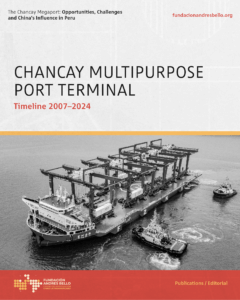
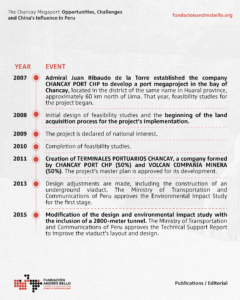
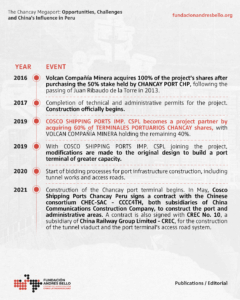
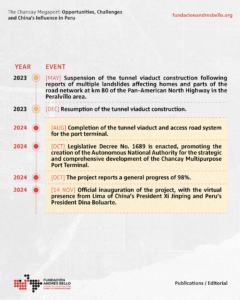
Chancay is not just a port, but one more piece in China’s global strategy to position itself as a commercial and political leader in regions that have traditionally been under the influence of other powers, such as the United States and Europe.
Despite optimism in several commercial sectors, the construction of the mega-port has not been without its problems and irregularities, including the controversial concession of areas reserved for national defense, the granting of permits without prior environmental studies, the acquisition of public lands at low cost, and negative impacts on local communities due to property damage. Additionally, the project has been marked by incidents of harassment toward journalists attempting to cover its development, raising concerns about transparency and respect for the rights of affected communities.
“The Peruvian state lacks involvement in this type of project to compensate and generate a business climate,” Narrea admits.
In addition, local communities have expressed concern about the social and economic impact of the project. The construction of the port has generated an increase in heavy traffic on the region’s roads, affecting air quality and noise levels in inhabited areas. Fishermen, in particular, have reported that the work has disrupted their activities, and fear that the port will permanently affect their livelihoods.
Despite these problems, the Chancay mega-port presents a number of benefits that could transform Peru’s economy and its position in global trade. The port is designed to be a strategic point of connection between South America and Asia, particularly with China, Peru’s largest trading partner.
The port will enable Peru to become a key logistics hub in the Pacific region, significantly reducing freight transport times to and from Asia. Analysts point out that the particularities of the port of Chancay will allow a reduction in transportation costs of around 30%, which will make Peru significantly more competitive with other countries in the region.
Currently, most of the shipments from South America to Asia go through the Panama Canal or require longer routes that include transferring cargo in other countries. Chancay, with its strategic location and modern infrastructure, is expected to reduce these times and costs, facilitating the direct flow of goods.

Photo: Presidencia Perú Flickr. Inspection of the progress of the Chancay Port Terminal and presentation of the first electric cranes. 14/06/2024
Its regional geopolitical impact will be undeniable, as it will also function as a commercial distribution center redirecting cargo to Ecuador, Chile, and Colombia, along with its connection to the Amazon Multimodal Corridor of the Northeastern Bioceanic Corridor linking Brazil and Peru.
This scenario is especially beneficial for Peruvian exports, such as minerals, agro-industrial products and fishing, key sectors of the national economy. The port is also expected to attract new foreign investment, both in the industrial sector and in related infrastructure, generating thousands of direct and indirect jobs.
China’s role in the development of the port of Chancay cannot be underestimated. Chinese investment has been crucial in financing the project, but its influence on Peru’s strategic infrastructure has also sparked debate.
Some experts see this collaboration as an opportunity for Peru to improve its infrastructure without relying exclusively on multilateral loans or public finance. In a country with a great need for modernization in its transportation and logistics system, the injection of Chinese capital is seen as a relief.
However, other analysts warn about the risks of relying so heavily on China. COSCO being a state-owned company, it is feared that control of such an important port could affect Peru’s economic and political sovereignty in the long term. In this sense, the criticism goes beyond the port of Chancay and focuses on China’s growing influence in strategic sectors in Latin America, from mining to infrastructure.
Ultimately, the Port of Chancay represents the opportunities and risks brought by globalization. For Peru, it could mean an economic transformation and better integration into international trade routes. However, questions about foreign influence and the impact on local communities will remain part of the debate as the port becomes a reality.
The challenge for Peru will be to maximize the port’s economic and commercial benefits while remaining vigilant about the environmental, social, and geopolitical implications accompanying this monumental project. Over time, Chancay may not only connect Peru with Asia but also redefine the country’s role in the Pacific trade dynamics.
Related News:
Peru loses $300 million to illegal fishing by Chinese fleets
China invests over US$11 billion in Peruvian mining projects
External Links: (Spanish)
Chancay: impacto geopolítico y comercial del Mega Puerto chino en Perú – Más Producción

